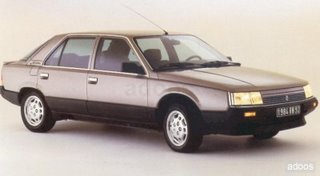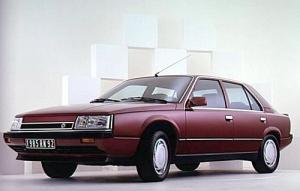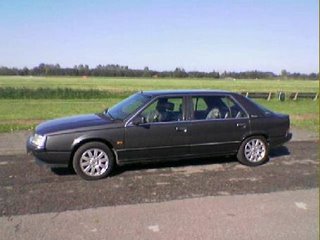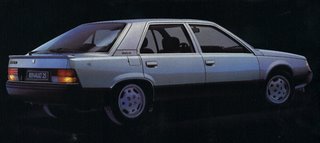



The Renault 25 is an executive car produced by the French automaker Renault from 1983 to 1992. The most luxurious and upmarket Renault ever at the time, it placed second in the 1985 European Car of the Year contest. Though the 25 suffered from reliability problems (particularly in models built before the car's 1988 revamp) it was consistently a reasonably good seller in its native France, despite failing to challenge the dominance of German brands in the executive car sector in the rest of the European markets. All 25s were built in Sandouville, near Le Havre, France.Introduced in late 1983 as a 1984 model, the Renault 25 was a large step forward in nearly every aspect from the Renault 20 / Renault 30 range it was replacing. Its five-door liftback body was penned by designer Robert Opron of Citroën SM fame, and the unconventional style (the wraparound rear window was its most famous feature) was aimed at giving the car a notchback look in order to overcome customer preference outside France for formal sedans in the segment.
The 25 was one of the first cars designed from the start for aerodynamic efficiency (Drag coefficient 0.31) — a key factor in improving fuel economy. The TS model briefly held the unofficial title of "world's most aerodynamic mass-production car" with a Cd (drag coefficient) of 0.28, and at its launch the 25 was easily the best in its class for fuel economy.
All Renault 25 models were front-wheel drive, with 4 or 6-cylinder engines mounted longitudinally forward of the front axle. The 25's performance was above average for its class, with the V6 Turbo specification a match for the Mercedes-Benz E-Class and BMW 5-Series.
The 25 was praised for its ride comfort and spirited handling (despite slight understeer, and torque steer on V6 Turbo models). A newly designed manual transmission drew unanimous praise for its precision and smoothness, and though the futuristic interior designed by Italian designer Marcello Gandini (of Lamborghini fame) was controversial, the 25 was highly regarded for its quiet, spacious and well-lit passenger compartment.
Equipment levels were high and set new standards for French cars, the 25 including among other features, an express-up and down feature on the driver's power window, voice alerts, and one of the world's first steering-wheel-mounted stereo controls. For the first time since World War II, Renault had a realistic chance of breaking into the full-size market segment outside of France.
The 25 was one of the first cars designed from the start for aerodynamic efficiency (Drag coefficient 0.31) — a key factor in improving fuel economy. The TS model briefly held the unofficial title of "world's most aerodynamic mass-production car" with a Cd (drag coefficient) of 0.28, and at its launch the 25 was easily the best in its class for fuel economy.
All Renault 25 models were front-wheel drive, with 4 or 6-cylinder engines mounted longitudinally forward of the front axle. The 25's performance was above average for its class, with the V6 Turbo specification a match for the Mercedes-Benz E-Class and BMW 5-Series.
The 25 was praised for its ride comfort and spirited handling (despite slight understeer, and torque steer on V6 Turbo models). A newly designed manual transmission drew unanimous praise for its precision and smoothness, and though the futuristic interior designed by Italian designer Marcello Gandini (of Lamborghini fame) was controversial, the 25 was highly regarded for its quiet, spacious and well-lit passenger compartment.
Equipment levels were high and set new standards for French cars, the 25 including among other features, an express-up and down feature on the driver's power window, voice alerts, and one of the world's first steering-wheel-mounted stereo controls. For the first time since World War II, Renault had a realistic chance of breaking into the full-size market segment outside of France.





No comments:
Post a Comment